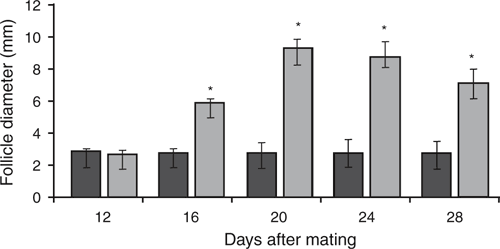Administration of human chorionic gonadotropin in early pregnancy increases ovarian activity in sows
J. Seyfang A C , T. Y. Chen B , P. Langendijk B and R. N. Kirkwood AA The University of Adelaide, Roseworthy, SA 5371.
B South Australian Research and Development Institute, Roseworthy, SA 5371.
C Corresponding author. Email: jemma.seyfang@adelaide.edu.au
Animal Production Science 55(12) 1508-1508 https://doi.org/10.1071/ANv55n12Ab068
Published: 11 November 2015
Reproductive performance is affected by variables such as nutrition and season, which can have a negative effect on ovarian function (Greer 1983; Stalder et al. 2004). Human chorionic gonadotropin (hCG) increases ovarian follicle growth in gonadotropin-treated gilts and increases steroid production in these gilts and in pregnant sows by virtue of its luteinising hormone-like activity. Literature, regarding an hCG effect on follicle growth in mated sows, is not evident. However, there is potential to use hCG after mating in early pregnancy if follicle growth occurs and increases oestrogens, as this could reinforce the embryonic signal for maternal recognition of pregnancy. This could then improve pregnancy maintenance and subsequent litter size. The aim of this pilot study was to test the hypothesis that administration of hCG on day 12 after mating would induce ovarian follicular growth during early pregnancy.
During lactation, 36 sows were assigned to receive a restricted feed intake of 4 kg/d for parity one, and 5 kg/d for parity two or three during the final 10 days of a 28 day lactation, with the objective of simulating lower feed intakes associated with summer. At 12 days after mating, 17 sows received an intramuscular injection of 1,000 IU hCG [Intervet (Pty.) Ltd]; this dose was based on Tilton et al. (1989). The diameters of the 10 largest ovarian follicles were measured for each sow by transrectal ultrasound on d 12, 16, 20, 24, and 28 after mating. Differences between days for mean follicle diameters were compared using the GLM procedure with treatment, day, treatment × day interaction, and parity as fixed effects (SAS®; USA).
Follicle size was increased (P < 0.01) on d 16 to 28 after mating by hCG treatment (Fig. 1). Maximum follicle size occurred on d 20 for hCG-treated sows at 9.1 mm compared to 2.8 mm for non-treated sows. Thereafter, follicle size decreased for the hCG treated group. There were no detrimental effects on reproductive performance in the next parity (data not shown). Sows that did not receive hCG did not exhibit any follicular growth during this period.

|
The increased follicle growth attributed to the hCG treatment could prove beneficial in early pregnancy if this follicle growth occurs with production of oestrogen, potentially reinforcing the signal for maternal recognition of pregnancy. Additionally, by d 12 of gestation corpora lutea respond to luteinising hormone stimulation with increased progesterone production potentially improving individual embryo survival. Further work should explore endocrine effects and whether these results translate to increased farrowing rates and litter sizes.
References
Greer E (1983) Heat stress and reproduction in pigs: its role in seasonal infertility. Recent Advances in Animal Nutrition in Australia 7, 216–230.Stalder K, Knauer M, Baas T, Rothschild M, Mabry J (2004) Pig News and Information 25, 53–74.
Tilton JE, Schmidt AE, Weigl RM, Ziecik AJ (1989) Theriogenology 32, 623–631.
| Crossref | GoogleScholarGoogle Scholar |
This project was funded by the Ronald Lienert Memorial Scholarship. We thank Emmy Bouwman for technical assistance.


 ); Restricted Feed +hCG (
); Restricted Feed +hCG ( ).
).